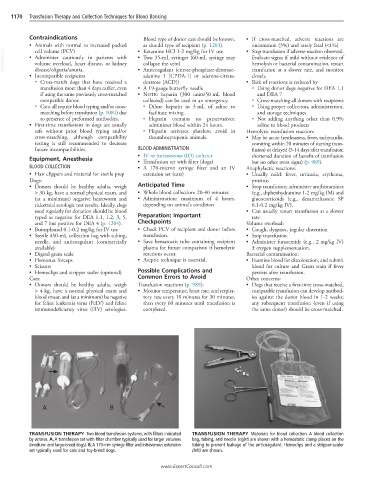Page 2366 - Cote clinical veterinary advisor dogs and cats 4th
P. 2366
1170 Transfusion Therapy and Collection Techniques for Blood Banking
Contraindications Blood type of donor cats should be known, • If cross-matched, adverse reactions are
uncommon (3%) and rarely fatal (<1%)
as should type of recipient (p. 1203).
• Animals with normal to increased packed • Ketamine HCl 1-2 mg/kg for IV use • Stop transfusion if adverse reaction observed.
VetBooks.ir • Administer cautiously in patients with • Two 35-mL syringes (60-mL syringe may Evaluate signs; if mild without evidence of
cell volume (PCV)
collapse the vein)
volume overload, heart disease, or kidney
hemolysis or bacterial contamination, restart
disease/oliguria/anuria.
adenine 1 [CPDA-1] or adenine-citrate-
closely.
• Incompatible recipients • Anticoagulant (citrate-phosphate-dextrose- transfusion at a slower rate, and monitor
○ Cross-match dogs that have received a dextrose [ACD]) • Risk of reactions is reduced by
transfusion more than 4 days earlier, even • A 19-gauge butterfly needle ○ Using donor dogs negative for DEA 1.1
if using the same previously cross-matched • NOTE: heparin (300 units/50 mL blood and DEA 7
compatible donor. collected) can be used in an emergency. ○ Cross-matching all donors with recipients
○ Cats: all require blood typing and/or cross- ○ Dilute heparin in 3 mL of saline to ○ Using proper collection, administration,
matching before transfusion (p. 1084) due facilitate mixing. and storage techniques
to presence of preformed antibodies. ○ Heparin contains no preservatives: ○ Not adding anything other than 0.9%
• First-time transfusions in dogs are usually administer blood within 24 hours. saline to blood products
safe without prior blood typing and/or ○ Heparin activates platelets; avoid in Hemolytic transfusion reaction:
cross-matching, although compatibility thrombocytopenic animals. • May be acute (restlessness, fever, tachycardia,
testing is still recommended to decrease vomiting within 20 minutes of starting trans-
future incompatibilities. BLOOD ADMINISTRATION fusion) or delayed (3-14 days after transfusion;
• IV or intraosseous (IO) catheter shortened duration of benefit of transfusion
Equipment, Anesthesia • Transfusion set with filter (dogs) but no other overt signs) (p. 989).
BLOOD COLLECTION • A 170-micron syringe filter and an IV Anaphylactic reactions:
• Hair clippers and material for sterile prep extension set (cats) • Usually mild: fever, urticaria, erythema,
Dogs: pruritus
• Donors should be healthy adults, weigh Anticipated Time • Stop transfusion; administer antihistamines
> 30 kg, have a normal physical exam, and • Whole blood collection: 20-40 minutes (e.g., diphenhydramine 1-2 mg/kg IM) and
(at a minimum) negative heartworm and • Administration: maximum of 4 hours, glucocorticoids (e.g., dexamethasone SP
rickettsial serologic test results. Ideally, dogs depending on animal’s condition 0.1-0.2 mg/kg IV).
used regularly for donation should be blood • Can usually restart transfusion at a slower
typed as negative for DEA 1.1, 1.2, 3, 5, Preparation: Important rate
and 7 but positive for DEA 4 (p. 1204). Checkpoints Volume overload:
• Butorphanol 0.1-0.2 mg/kg for IV use • Check PCV of recipient and donor before • Cough, dyspnea, jugular distention
• Sterile 450-mL collection bag with tubing, transfusion. • Stop transfusion.
needle, and anticoagulant (commercially • Save hematocrit tube containing recipient • Administer furosemide (e.g., 2 mg/kg IV)
available) plasma for future comparison if hemolytic ± oxygen supplementation.
• Digital gram scale reactions occur. Bacterial contamination:
• Hemostat forceps • Aseptic technique is essential. • Examine blood for discoloration, and submit
• Scissors blood for culture and Gram stain if fever
• Hemoclips and stripper sealer (optional) Possible Complications and persists after transfusion.
Cats: Common Errors to Avoid Other concerns:
• Donors should be healthy adults, weigh Transfusion reactions (p. 989): • Dogs that receive a first-time cross-matched,
> 4 kg, have a normal physical exam and • Monitor temperature, heart rate, and respira- compatible transfusion can develop antibod-
blood smear, and (at a minimum) be negative tory rate every 10 minutes for 30 minutes, ies against the donor blood in 1-2 weeks;
for feline leukemia virus (FeLV) and feline then every 60 minutes until transfusion is any subsequent transfusion (even if using
immunodeficiency virus (FIV) serologies. completed. the same donor) should be cross-matched.
A B
TRANSFUSION THERAPY Two blood transfusion systems, with filters indicated TRANSFUSION THERAPY Materials for blood collection. A blood collection
by arrows. A, A transfusion set with filter chamber typically used for larger volumes bag, tubing, and needle (right) are shown with a hemostatic clamp placed on the
(medium- and large-breed dogs). B, A 170-mm syringe filter and intravenous extension tubing to prevent leakage of the anticoagulant. Hemoclips and a stripper-sealer
set typically used for cats and toy-breed dogs. (left) are shown.
www.ExpertConsult.com

